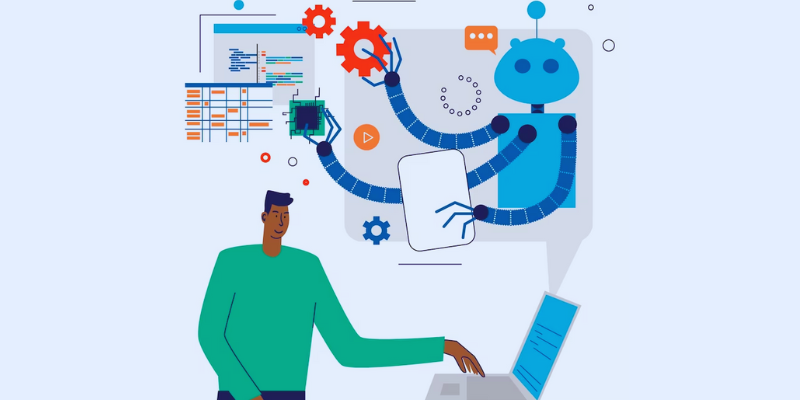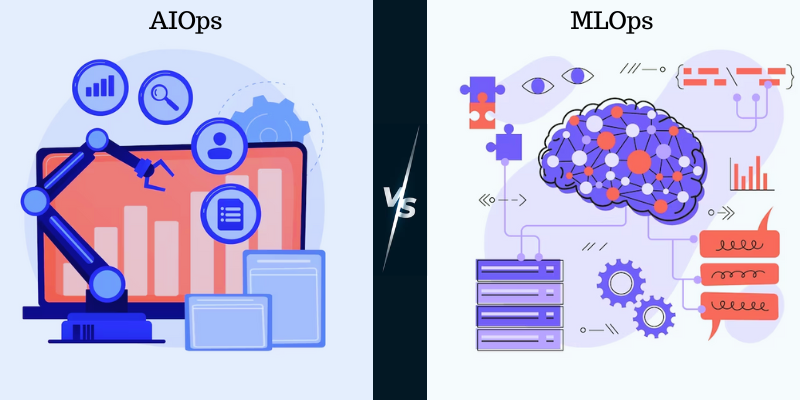Artificial intelligence (AI) and machine learning (ML) are evolving, and organizations are adopting these technologies rapidly as they undergo digital transformations.
AIOps and MLOps are two crucial components of AI-powered businesses. Several enterprises use these technologies in recent years to improve their product and services and boost customer satisfaction.
AI operations are a series of multiple-layer platforms that help automate IT operations, whereas ML operations are a disciplinary approach to control machine learning algorithms on ongoing products.
In this article, I’ll discuss AIOps and MLOps, their importance, and how they differ from each other.
Here we go!
What Is AIOps?

Artificial Intelligence for IT Operations (AIOps) is a combination of machine learning and big data that automates almost various IT operations, such as event correlation, casualty determination, outlier detection, and more.
AIOps was first termed by Gartner in the year 2016. According to them, AIOps is a great platform for IT operations that utilize modern machine learning techniques, big data, and other advanced technologies to indirectly or directly enhance service desk, monitoring, and automation functions.
AIOps platforms allow organizations to use different data collection methods, data sources, presentation technologies, and analytical technologies. AIOps is instrumental for many tasks:
- Traces, logs, system configuration status, incident data, and other information related to the system operation and performance
- Examines the collected data and draws conclusions accordingly using priority patterns
- AIOps can suggest solutions accurately to make the operation faster
- It can solve complex problems without human interference.
Thus, in simple words, AIOps uses AI technology to optimize and automate IT tasks, which is also referred to as a self-optimizing technology. The primary goal of AIOps is to maximize performance by minimizing downtime.
What Is MLOps?

Machine Learning Operations (MLOps) is a framework that aims at an increased collaboration between the operations unit and data scientists within an organization. It is a multiple-disciplinary approach that helps manage ML algorithms on ongoing products with their own continuous lifecycle.
MLOps is a technology that allows you to scale, build, and deploy multiple algorithms to maintain consistency in production. It combines tools and people, covering three major aspects of ML, i.e., design, deployment, and training.
Furthermore, MLOps also lets you analyze, collect, and interpret various data. With several machine learning algorithms, it can detect anomalies in the infrastructure that might be causing issues in performance. In addition, it uses historical analytics results for optimized and efficient future operations.
MLOps’ goal is to use ML algorithms to automate various repeatable tasks in your data science projects. It uses advanced deep learning algorithms for large data processing instead of traditional business intelligence applications.
A typical MLOps has several processes:
- Defining business goal
- Collecting important data
- Processing and cleaning data
- Building models or using ready-to-deploy models
- Deploying the final model
MLOps follows a similar path as DevOps, except that developers are specifically data scientists, machine learning engineers, and AI specialists in MLOps. DevOps creates better products by shortening the lifecycle of the product, whereas MLOps drives insights to use it further and obtain better results.
MLOps encourages data scientists to try various parameters, models, and features. Thus, you can say it is experimental in nature.
Why is AIOps Essential?

AIOps help with intelligent alerts and analytics in the event of an outage or system failure. You will find a versatile approach to the management of application performance, given that you can quickly track business transactions with respect to application functions.
AIOps can solve various challenges; let’s discuss them
Compliance Auditing
The major benefit of AIOps is identifying non-compliance issues with regulatory standards. Such standards include:
- ISO 27001/27002
- Payment Card Industry Data Security Standard (PCI DSS)
- Sarbanes-Oxley Act (SOX)
- Health Insurance Portability and Accountability Act (HIPAA)
These standards and regulations are built to secure sensitive data by using strong encryption, proper disposal procedures, access control measures, and more.
Anomaly Detection
Identifying various patterns in data and detecting the data that falls outside the normal is called anomaly detection. With multiple machine-learning models that are trained based on historical data, AIOps can detect situations where unusual actions take place for specific applications or users.
Regulatory Reporting

Regulators require companies to produce a report on how they abide by the industry guidelines, including HIPAA, PCI, and others. Manually generating these kinds of reports is time-consuming and tedious, especially when you are managing numerous servers or several applications.
However, AIOps solutions allow you to automate compliance audits with real-time monitoring of the whole infrastructure.
Noise Reduction
Noise reduction is crucial for the collected data. When reviewing event data and logs, unwanted noise (data) interferes with important information. Excessive noise wastes resources and time since it requires human effort to sort irrelevant events. High noise levels indicate issues with software design and underlying vulnerabilities.
AIOps solutions can filter extraneous data so that you can focus on meaningful signals, resulting in better efficiency and production.
End-to-End Process Monitoring
AIOps offers data about all the organization’s technology assets, how they perform, and insight into how they are used. AIOps solutions provide proper visibility to the organization across multiple IT operations, such as application management and deployment, security analytics, and network monitoring.
Why is MLOps Essential?
MLOps enable organizations to become successful and more efficient with data-driven analysis. It also enhances operational intelligence so that decision-makers can make valuable decisions for the organization’s higher success.
There are many benefits of MLOps solutions:
Risk Mitigation

The risks involved with ML models can be easily mitigated with MLOps solutions since they provide tools to monitor how well every model performs over a period of time. This information allows organizations to determine whether a particular model needs to be replaced or updated with a new version.
Automated Development
Automated development allows data scientists to build, test and train machine learning models more quickly. In addition, MLOps can be deployed in days rather than months. They allow developers to get faster results and improve models. This will further reduce costs and free up resources.
Deployment Flexibility
MLOps make deployment easy on any node, making it possible for development teams to use their infrastructure for testing and training.
Regulatory Compliance
Since organizations handle sensitive information, they must comply with regulatory requirements to protect privacy. Turning to MLOps solutions is a wise decision because these are designed especially to meet compliance. This will allow users to test and train machine learning models without leaking any personal information.
Repeatable Workflows

MLOps simplifies repeatability by offering pre-built workflows for easy-going tasks, such as model training, deployment across environments, and validation.
Rapid Threat Response
When IT professionals find a hole in the security shield, they must act quickly to minimize the damage and prevent future attacks. MLOps solutions will be available all the time, and at the time of a security breach, it suddenly identifies threats and prevents similar events in real time. In addition, you will also get insights into the damage caused due to a breach.
Use Cases of AIOps
AIOps is useful for organizations that use cloud computing or DevOps. It aids DevOps teams in gaining additional insights into their organization’s IT environment. The operations team also gets visibility into the production changes.
AIOps applications are built on four major components:
- Enterprise monitoring
- Application performance monitoring (APM)
- Security monitoring and management (SMM)
- Network performance management (NPM)

In addition, AIOps supports a vast range of IT operations to improve cost efficiency, minimize delays and errors, etc. let’s discuss some common use cases:
Quick alerting
AIOps solutions filter and ingest data from IT environments to consolidate alerts and identify incidents. For example, if a failure in a system results in the failure of another system, then you will receive many notifications that confuse you and also slow down the response time. But AIOps can gather all the information, analyze them, and then send an alert so that IT teams can understand the issue and provide a correct response, reducing alert fatigue.
Cross-domain situational analysis
AIOps platforms can analyze the data from various networks and systems to give a bird’s-eye view of the current situation. This will help an IT team understand what is at risk so that they can prioritize their responses according to the business objectives.
Identification of root causes
AIOps platforms help identify the root causes of different incidents to minimize the time-consuming and frustrating troubleshooting process. You can allow your IT team to get to the problem and solutions faster and eliminate MTTR and minimize downtime.
Cohort analysis
AIOps solutions gather numerous information from distributed architectures and analyze a wide range of instances. This process helps you find the outliers in the configuration, select meaningful patterns, and deploy the correct software versions rapidly.
Apart from this, there are many other use cases of AIOps, including self-healing capabilities, the discovery of hidden opportunities, capacity planning, incidence management, cloud optimization, etc.
Use Cases of MLOps

MLOps has a wide range of uses across many industries, from healthcare to finance. Some of them are:
Vaccine Research and Discovery
Healthcare companies face problems like prolonged research, technology mismatch, technical debt, stakeholder buy-in, etc. MLOps offers an excellent technological stack to screen thousands of virtual compounds swiftly and cost-effectively.
Data processing
Data processing industries face problems like security, governance, cloud adoption, data protection, and more. MLOps enables data processing companies to counter these problems and lets them compute resources, accelerate model deployment, and ensure reproducibility.
Model deployments in finance
Financial firms provide services like advising, tax assurance, etc. These firms harness ML technologies for anti-money laundering, checking economic compliance, trade surveillance, fraud detection, and more. By implementing MLOps, they can reliably accelerate deployments using libraries and frameworks.
Maintenance operations
MLOps helps the maintenance and operations team focus on data science. Without the use of costly resources, your team can review every component on a priority basis. This further helps in large-scale experimentation.
Shipment volume accuracy
Logistics companies face issues like complexities in predicting volumes of shipment, requirements in additional arrangements, existing tools challenges, and more. By implementing MLOps, you can solve these challenges and gain benefits like enhanced accuracy in prediction, streamlined operations, and reduced workloads.
AIOps vs. MLOps: Differences

Artificial intelligence has two pillars: Machine learning and Deep learning. Thus, artificial intelligence is a multi-layer technology. On the other hand, MLOps is used to bridge the gap between data scientists and operation teams.
Let’s find out some more differences between AIOps and MLOps.
| AIOPS | MLOPS |
| AIOps automate IT systems and operations. | MLOps standardizes the machine learning system development process. |
| It automates root cause resolution and analysis. | It enhances the productivity and efficiency of a team. |
| It manages and processes a wide range of information effectively and efficiently. | It plays a crucial part in deploying data science and artificial intelligence at scale, in a repeatable manner. |
| AIOps manages the vulnerability risks continuously. | MLOps manages the machine learning lifecycle. |
| It enables preventive maintenance and provides proactive alerts. | It ensures fairness and mitigates bias through model validation. |
| Its tasks include anomaly detection, causality determination, event correlation, and more. | It includes machine learning models and embeds, continuous learning, and performance monitoring. |
Learning Resources on AIOps
Some of the learning resources on AIOps are as follows:
#1. Hands-on AIOps
| Preview | Product | Rating | |
|---|---|---|---|

|
Hands-on AIOps: Best Practices Guide to Implementing AIOps | Buy on Amazon |
This guide offers in-depth knowledge of the fundamentals of machine learning and artificial intelligence. It also covers multiple use cases of AIOps using ML algorithms.
#2. AIOps Augmentation A Complete Guide
| Preview | Product | Rating | |
|---|---|---|---|

|
AIOps Augmentation A Complete Guide – 2021 Edition | Buy on Amazon |
The author of the book believes that the best way to understand technology is to ask questions. This guide includes questions and answers, different assessments on various AIOps tools, and more.
Learning Resources on MLOps
Some of the learning resources on MLOps are as follows:
#1. Introducing MLOps
| Preview | Product | Rating | |
|---|---|---|---|

|
Introducing MLOps: How to Scale Machine Learning in the Enterprise | Buy on Amazon |
This book is written by nine authors that have shared their knowledge in the book. You will find an introduction to the key concepts of MLOps and, later, some advanced tools. This book helps you learn data science, refine ML models, design the MLOps lifecycle, operationalize ML models, and so on.
#2. Practical MLOps
| Preview | Product | Rating | |
|---|---|---|---|

|
Practical MLOps: Operationalizing Machine Learning Models | Buy on Amazon |
Authors Noah Gift and Alfredo Deza give you a head start on applying DevOps best practices to ML, building production ML systems, monitoring, load-testing, instrumenting ML systems, choosing the correct MLOps tools, running ML models, and more.
Conclusion
AIOps and MLOps are similar but different in their own terms and applications. But they both help you make your systems and processes more efficient.
AIOps focuses on intelligent root cause analysis and automating incident management, whereas MLOps bridges the gap between operation teams and data scientists.
Also, AIOps automates machines or systems in your organization while MLOps standardizes your IT processes.
You may also explore top learning resources for data science and machine learning.

